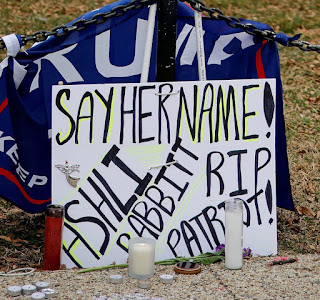Review of Robyn Marasco’s “Reconsidering the Sexual Politics of Fascism” – Matthew N. Lyons, Three-Way Fight
 |
| Memorial to Ashli Babbitt, killed during January 6 attack on U.S. Capitol |
Most critiques of the far right take women for granted. Either they ignore women entirely, or they assume that far right gender politics are simple and straightforward: The far right is really, really sexist. What more do we need to know? There are at least two problems with this. First, if far right movements just want to intensify women’s oppression, why have so many of them attracted women in large numbers? Second, if the far right’s gender politics are uncomplicated, why have they involved so many conflicts – between efforts to recruit women and efforts to exclude them, between celebrations of “the traditional family” and celebrations of men’s predatory sexuality, between calls to build up the authority of husbands and fathers and calls to subordinate all relationships to the demands of the state?
“[C]an we speak of the fascisation without speaking of sex? … Will we understand how online misogyny becomes gateway drug to Far Right, how the world of men’s rights activists, pick-up artists, MGTOW trolls, and ‘involuntary celibates’ overlaps with that of white supremacists, militia men, and proud boys, or even how a relatively minor episode like #gamergate could be plausibly described [as] one of the inaugural events of the Trump era? Will we recognise in the ‘Great Replacement’ myth a bid for control of women’s sexuality, as well as racist and culturalist panic? Even more to my point here, without seeing sex as an instrument of fascisation, can we make sense of the anti-vaxxers, yoga moms, and wellness gurus who are part of the new Right resurgence, how the Q-anon conspiracy mobilises women’s fears for their children? … Can we comprehend a political situation in which Trans-Exclusionary Radical Feminists (TERFs) do the bidding of religious fundamentalists and cultural nationalists? Will we grasp why trans liberation is not only a feminist but also an antifascist project?”
To help craft her analysis, Marasco draws on the work of two second-wave feminists, Maria Antoinetta Macciochi and Andrea Dworkin. Both saw the mobilization of women as pivotal to the far right’s success and advanced theories of “female antifeminism” to explain it, yet the two writers worked within very different frameworks and offered sharply contrasting interpretations. In La Donna “Nera”: Consenso Femminile e fascismo (1976) Macciochi combined Marxist, feminist, and psychanalytic theory to argue that women’s support for fascism represented a form of mass irrationalism, a political choice that ran directly counter to most women’s interests. Dworkin, by contrast, drew on neither Marx nor Freud, and in Right-Wing Women: The Politics of Domesticated Females (1983) she argued that women’s support for the “Ultra-Right” (typified by militant campaigns against abortion rights and the Equal Rights Amendment) was in many cases a rational choice, an acceptance of subordination in exchange for safety and protection in a world dominated by male aggression and violence, when other options did not seem available.
Both Macciochi and Dworkin were complicated figures. Macciochi joined the Italian Communist Party while it was underground during World War II, championed Gramscian thought in the 1960s but was expelled from the PCI in 1977 for embracing Maoism, and later moved toward a kind of Christian Democratic liberalism. Dworkin, a pioneer of American radical feminism, is now most often remembered for her anti-pornography crusade, which Marasco describes as “a complete disaster.” Marasco continues,
“Her writing has been rightly criticised for its neglect of the powers and privileges that give white women a significant stake in white supremacy…. [Yet in Right-wing Women] she recognizes that ‘female antifeminism’ takes shape in opposition to the interests of Black women, lesbian women, trans women, poor women, all sorts of women for whom the protections of the patriarchal family are unavailable.”
 |
| Phyllis Schlafly protesting at White House against the Equal Rights Amendment, 1977 |
Macciochi and Dworkin are both largely ignored in discussions of far right politics today. (I was previously unaware of Macciochi’s work on fascism, only a fraction of which has been translated into English, but Dworkin’s Right-Wing Women has significantly shaped my own thinking on the subject.) It’s a strength of Marasco’s analysis that she finds value in both writers’ approaches, arguing that neither one is adequate alone, yet together they help us understand why some women embrace the far right and what it means to them.Marasco grounds her theoretical discussion in a close examination of Ashli Babbitt, the Trump supporter who was shot and killed while participating in the January 6th invasion of the U.S. Capitol, and who has since been held up as a martyr to the cause—the right’s answer to Heather Heyer or Breonna Taylor. Marasco emphasizes that Babbitt doesn’t fit earlier prototypes of right-wing women: Macciochi’s “mournful Madonna” or Dworkin’s mobilized housewife:
“[Babbitt] embodies neither traditional nor mythic femininity. Indeed, Ashli was more like one of the guys. A veteran of the wars in Iraq and Afghanistan, Babbitt served 14 years in United States Air Force… In photographs that circulated after her death, she embodies the sun-kissed, tomboy sexuality of a sex-integrated society (and military): ponytail, red MAGA cap, tank tops, fatigues, sunglasses, cutoff denim, American flags, in flexed pose. Ashli was divorced and remarried, with no children, living with her second husband and his girlfriend in what tabloids say was a ‘throuple’ but was, at any rate, not entirely conventional. Her Twitter feed indicates that she once voted for Barack Obama but was ‘radicalised’ by an intense hatred of Hillary Clinton. She found other targets in Nancy Pelosi, Maxine Waters, and Kamala Harris…. When she left for the Capitol protest, she was the owner of a failing pool supply shop in suburban San Diego, deep in debt. The sign on the door of her storefront declared it a ‘Mask Free Autonomous Zone’ in protest against the state’s Covid-19 restrictions. Further down, the sign read: ‘We shake hands like men.’”
“The martyrdom of Ashli Babbitt,” Marasco notes, “underscores Macciocchi’s argument about a ‘death drive’ at the root of fascism and its peculiar expressions in women. It confirms Dworkin’s hunch that the new right-wing women would be the product of the feminist movement that they oppose.” Yet Marasco’s interpretation of Babbitt’s larger significance also moves beyond Macciochi’s and Dworkin’s insights to sketch a portrait of female antifeminism that is specific to our historical moment and highlights the current far right’s contradictory response to neoliberalism:
“If the ‘Ultra-Right’ (Dworkin’s term) had once promised white women the security and safety of patriarchal domesticity, today it offers something else, something more immediately transgressive, more responsive to destructive impulses and antisocial forces, and more proximate to the equality that it rejects and the freedom it renounces. It offers white women an account of their unhappiness and an affective arena to express their rage. [Phyllis] Schlafly and other ‘movement conservatives’ once heralded ‘the power of the positive woman,’ but the Right today understands the power and potency of the negative. It relishes white women’s anger and feeds their resentment. It encourages their aggression. And this, I would suggest, is at least part of its appeal. It is not simply a question of protecting one’s interests (as white women, petit-bourgeois women, women with American citizenship), or even desiring one’s own domination, but of gaining access to the pleasures of ‘masculine’ affect and agency. It is a privilege reserved only for some women, which is part of the point. And it is a form of ‘female antifeminism’ that mirrors the neoliberal feminism it opposes, another degraded version of having it all, where instead of the corporate career and the heterosexual reproductive family, women can have combat training, AR 15s, polyamorous sexuality, conspiracism, and, above all, a semblance of power that substitutes for the real thing. Some women want a seat at the boardroom table. Others want to be in the eye of the storm.”
There are more useful insights in this one passage than in many whole books about the far right, and several points that invite further investigation. For example, what’s the relationship—ideologically and in practice—between right-wing women’s quest for “access to the pleasures of ‘masculine’ affect and agency” and right-wing men gravitating in recent years to exclusionary cults of male-bonding, as witness the Proud Boys, the manosphere-inflected alt-right, and Jack Donovan’s male tribalism?
In the spirit of Marasco’s strategy of bringing together multiple perspectives, I have three suggestions for ways to move the discussion forward. The first is to expand the scope of what we consider under the category of “far right.” In particular, along with the usual suspects of white nationalists and Proud Boys, Patriot groups and QAnon conspiracists, I believe it’s also important to include the hardline wing of the Christian right—direct descendant of Andrea Dworkin’s “Ultra-Right”—whose goal of a full-blown theocracy is every bit as authoritarian and dangerous as calls for a white ethnostate.
Second and related to the first, let’s recognize that the far right doesn’t offer one unified message to women, but rather multiple versions of female antifeminism that overlap in shifting ways. The promise of safety through patriarchal domesticity, for example, never went away, but in different contexts it has to varying degrees been combined with other messages. In the Quiverfull movement, right-wing Christian women are told not only to submit to the dictates of their husbands but also to have as many babies as possible to strengthen Christendom against unbelievers—and these demands do not always coincide. In New Apostolic Reformation, a powerful theocratic network within the Christian right, patriarchal traditionalism coexists uneasily with calls to “empower” women, some of whom are among the network’s top leaders.
Third, let’s take seriously the far right’s “transgressive” dimension as more than just rhetoric or fantasy. Marasco’s comment that “the Far Right activates conservative institutions… and affirms bourgeois values… to advance an authoritarian agenda” is only part of the story. For example, the far right’s celebration of male comradeship has sometimes included open homoeroticism, and demographic fears have sometimes prompted far rightists to advocate procreation outside of marriage, neither of which is in line with conservative institutions or bourgeois values.
More broadly, the far right promotes and feeds on both conformity and rebelliousness, because it embodies a contradictory relationship with the established order. It wants to bolster and intensify social hierarchies, but it challenges established elites and attacks political and cultural structures that it believes stand in the way of its supremacist (or genocidal) goals. In the process, the far right speaks not only to people’s fears that their traditional privilege is under threat from below, but also their sense of disempowerment from above. Yet the solutions it offers are anything but liberatory.
To combat this kind of threat, we need to take seriously the complexities of far right politics, and the complex human experiences of those who are drawn to it. Crucial here is the point with which Marasco closes “Reconsidering the Sexual Politics of Fascism”: to defeat the far right, the left needs to take “female antifeminism” seriously and counter it with a genuine and militant feminist politics.
Photo credits:
Ashli Babbitt memorial: Carlos Barria/Reuters.
Phyllis Schlafly: Warren K. Leffler, public domain, U.S. News & World Report Magazine Photograph Collection, Library of Congress, via Wikimedia Commons.
Leave a Reply